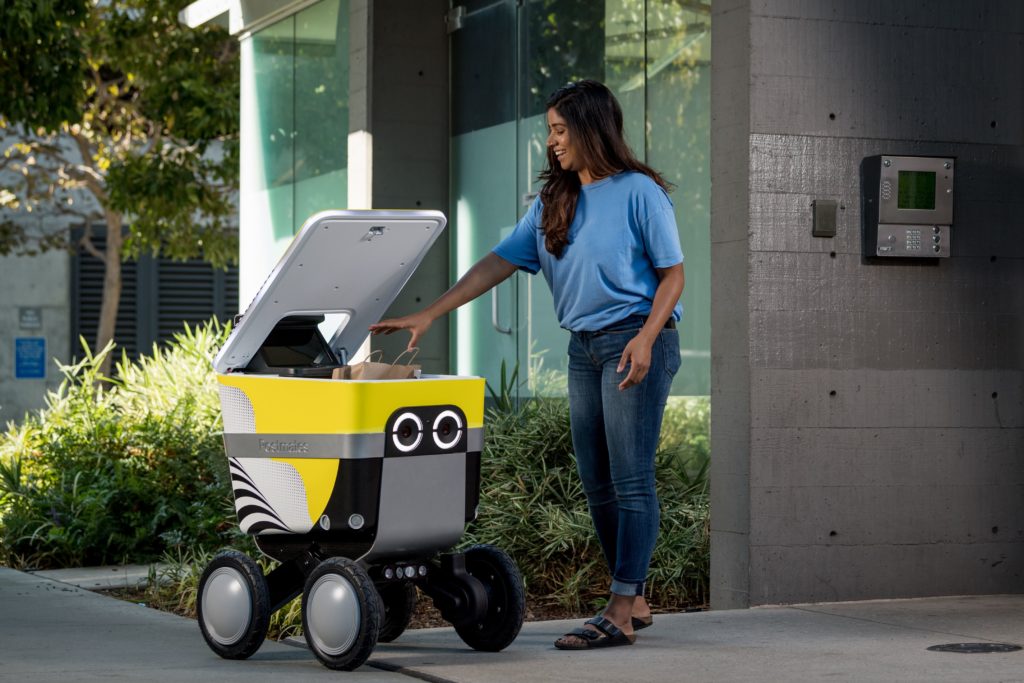Food delivery robots are no longer the stuff of science fiction. The knee-high robots — capable of transporting around four large pizzas — are now making their way around college campuses and large cities in the US, UK and Canada. While they were in the works prior to the COVID-19 pandemic, demand for contactless delivery caused a boom in the number of food delivery robots navigating the streets. So, how do they work and will they ever fully replace humans?
What are Food Delivery Robots?
Food delivery robots would not be possible without advancements in the fields of robotics, automation, navigation and GPS tracking. The semi-autonomous robots have four to six wheels and generally feature a flag so that pedestrians can spot them on their way to a delivery point. Since they are still being rolled out, a typical food delivery robot costs between $2,500 and $5,000, depending on the features.
Some semi-autonomous robots began hitting the streets of college campuses at the beginning of the pandemic, but have since become more widespread. As with other food delivery services, customers can purchase food through an app with vendors based on their location. The robot then makes its way to the vendor and then to the customer’s doorstep.
How Do Food Delivery Robots Work?
The robots can carry nearly 20lbs-worth of cargo, weigh around 55lbs and can travel at a maximum speed of four miles per hour. They use many of the same features as a self-driving car, including multiple cameras for 360-degree vision, ultrasonic sensors, measurement units and GPS navigation. Once an order is placed, the robot must map out the route between the vendor and the delivery point and consider sidewalks, crossings, vehicles, pedestrians and animals that all share the streets.
A primary example in the space is Starship Technologies, a San Francisco-based robot company with engineering facilities in Finland and Estonia. The company, which recently completed its two millionth delivery, has more than 1,000 robots in its fleet, up from only 250 two years ago. It plans to deploy hundreds more to college campuses and new cities soon.
“We saw demand for robot usage just go through the ceiling,” Alastair Westgarth, CEO of Starship Technologies, told the Associated Press. “I think demand was always there, but it was brought forward by the pandemic effect.”
Another company in the space is Serve Robotics, which started out as part of the food delivery service Postmates. After Uber purchased Postmates in late 2020 for around $2.65 billion, their robotics division split from its original brand, and in March 2021, they announced the creation of an independent company, called Serve Robotics.
In 2019, Serve was featured in Time Magazine’s 100 best inventions of the year. Like Starship’s robots, Serve’s semi-automated rovers drive on sidewalks with pedestrians and avoid poles and fire hydrants. Serve also requires a human brain behind its robots, for now, in case it encounters any issues.
Will Robots Replace Humans in Food Delivery?
The rise of contactless delivery has paved the way for more competitors in the food delivery robot space, including Nuro, Amazon’s Scout robot, Eliport, AutoX and Robomart. However, it is unlikely robots will be replacing humans at mass any time soon.
Robots have several drawbacks that limit their capabilities and usefulness. First, they are electric and must be recharged regularly. Second, they move at a slow pace and generally stay within a four-to-five-mile radius. Lastly, they don’t allow for special delivery instructions — customers can’t indicate where to leave their food, which can be limiting for condos and apartment complexes.
But in areas that food delivery robots can be deployed, they will likely grow in popularity. According to Verified Market Research, the global autonomous delivery robots market will be worth $ 236.59 million by 2027, at a compound annual growth rate (CAGR) of 34.30 percent. Whether the food delivery robot trend will fade remains to be seen, but for now, they will continue to roam the streets alongside pedestrians.












Join or login to leave a comment
JOIN LOGIN